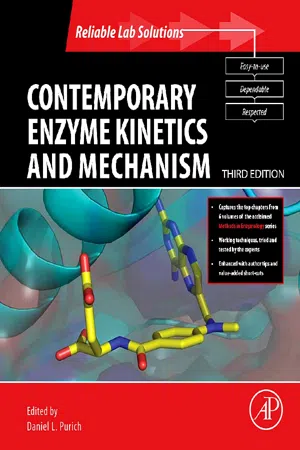
- 704 pages
- English
- ePUB (mobile friendly)
- Available on iOS & Android
About This Book
Kinetic studies of enzyme action provide powerful insights into the underlying mechanisms of catalysis and regulation. These approaches are equally useful in examining the action of newly discovered enzymes and therapeutic agents.
Contemporary Enzyme Kinetics and Mechanism, Second Edition presents key articles from Volumes 63, 64, 87, 249, 308 and 354 of Methods in Enzymology. The chapters describe the most essential and widely applied strategies. A set of exercises and problems is included to facilitate mastery of these topics.
The book will aid the reader to design, execute, and analyze kinetic experiments on enzymes. Its emphasis on enzyme inhibition will also make it attractive to pharmacologists and pharmaceutical chemists interested in rational drug design.Of the seventeen chapters presented in this new edition, ten did not previously appear in the first edition.
- Transient kinetic approaches to enzyme mechanisms
- Designing initial rate enzyme assay
- Deriving initial velocity and isotope exchange rate equations
- Plotting and statistical methods for analyzing rate data
- Cooperativity in enzyme function
- Reversible enzyme inhibitors as mechanistic probes
- Transition-state and multisubstrate inhibitors
- Affinity labeling to probe enzyme structure and function
- Mechanism-based enzyme inactivators
- Isotope exchange methods for elucidating enzymatic catalysis
- Kinetic isotope effects in enzyme catalysis
- Site-directed mutagenesis in studies of enzyme catalysis
Frequently asked questions
Information
- I. Derivation of Initial-Velocity Equations
- A. Steady-State Treatment
- B. The Rapid-Equilibrium Treatment
- C. The Combined Equilibrium and Steady-State Treatment
- II. Derivation of Isotope-Exchange Rate Equations
- A. Equations for Exchanges at Equilibrium
- B. Derivation by the Steady-State Method
- III. Concluding Remarks
- Addeendum
- References
I Derivation of Initial-Velocity Equations
- 1. The enzyme and the substrate form a complex.
- 2. The substrate concentration is much greater than the enzyme concentration, so that the free substrate concentration is equivalent to the total concentration. This condition further requires that the amount of product formed is small, such that the reverse reaction or product inhibition is negligible.
- 3. During the reaction, constant pH, temperature, and ionic strength are maintained.
Table of contents
- Cover
- Title Page
- Copyright
- Table of Contents
- Preface
- Contributors
- Chapter 1: Derivation of Initial-Velocity and Isotope-Exchange Rate Equations
- Chapter 2: Practical Considerations in the Design of Initial Velocity Enzyme Rate Assays
- Chapter 3: Techniques in Coupled Enzyme Assays
- Chapter 4: Regression Analysis, Experimental Error, and Statistical Criteria in the Design and Analysis of Experiments for Discrimination Between Rival Kinetic Models
- Chapter 5: Analysis of Enzyme Progress Curves by Nonlinear Regression
- Chapter 6: Effects of pH on Enzymes
- Chapter 7: Temperature Effects in Enzyme Kinetics
- Chapter 8: Site-Directed Mutagenesis
- Chapter 9: Cooperativity in Enzyme Function
- Chapter 10: Reversible Enzyme Inhibitors as Mechanistic Probes
- Chapter 11: Application of Affinity Labeling for Studying Structure and Function of Enzymes
- Chapter 12: Mechanism-Based Enzyme Inactivators
- Chapter 13: Transient Kinetic Approaches to Enzyme Mechanisms
- Chapter 14: Rapid Quench Kinetic Analysis of Polymerases, Adenosinetriphosphatases, and Enzyme Intermediates
- Chapter 15: Presteady-State Kinetics of Enzymatic Reactions Studied by Electrospray Mass Spectrometry with Online Rapid-Mixing Techniques
- Chapter 16: Isotope Exchange Methods for Elucidating Enzymic Catalysis
- Chapter 17: Positional Isotope Exchange as Probe of Enzyme Action
- Chapter 18: Enzymatic Transition-State Analysis and Transition-State Analogs
- Chapter 19: Determining Transition States from Kinetic Isotope Effects
- Chapter 20: Computational Methods for Transition State and Inhibitor Recognition
- Appendix: Selected Exercises and Problems
- Index